A Comprehensive Evaluation of Electricity Planning Models in Egypt: Optimization versus Agent-Based Approaches
Abstract
:1. Introduction
1.1. Sustainable Electricity Planning
1.2. Challenges of Electricity Supply in Egypt
2. Resource Potential
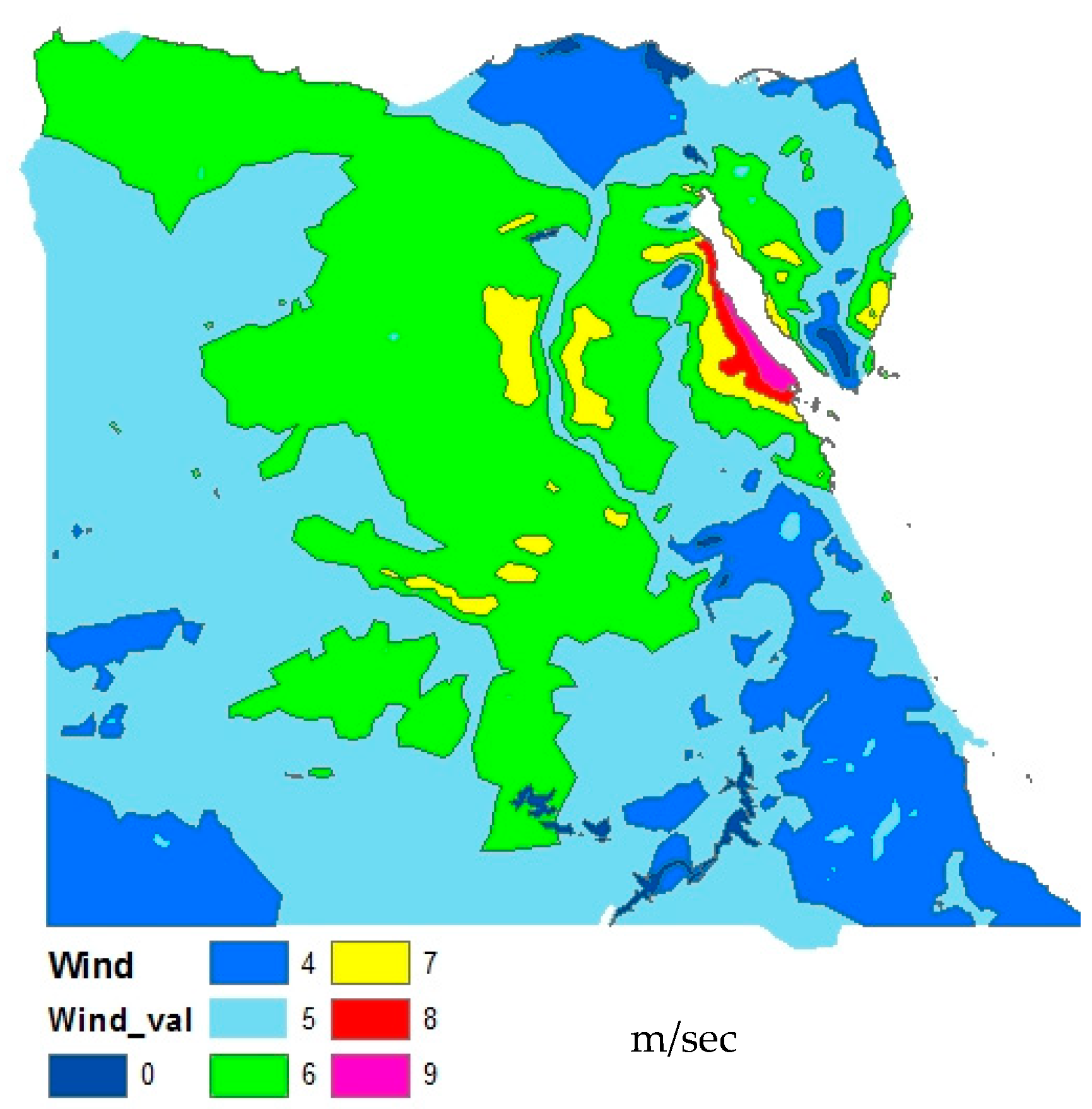
3. Amendments to the Electricity Policy
| Consumption Segment (kWh/Month) | Residential Sector (Egyptian Piasters/kWh) Year | |||||
|---|---|---|---|---|---|---|
| 2014/15 | 2015/16 | 2016/17 | 2017/18 | 2018/19 | 2019/20 | |
| 0–50 | 7.5 | 9 | 10 | 13 | 22 | 30 |
| 51–100 | 14.5 | 17 | 19 | 22 | 30 | 40 |
| 101–200 | 16 | 20 | 26 | 27 | 36 | 50 |
| 201–350 | 24 | 29 | 35 | 55 | 70 | 82 |
| 351–650 | 34 | 39 | 44 | 75 | 90 | 100 |
| 651–1000 | 60 | 68 | 71 | 125 | 135 | 140 |
| >1000 | 74 | 78 | 81 | 135 | 145 | 145 |
| Commercial (Egyptian Piasters/kWh) | ||||||
| 0–100 | 30 | 32 | 34 | 45 | 55 | 65 |
| 101–250 | 44 | 50 | 58 | 84 | 100 | 115 |
| 251–600 | 59 | 61 | 58 | 96 | 115 | 140 |
| 601–1000 | 78 | 81 | 86 | 135 | 145 | 155 |
| >1000 | 83 | 86 | 86 | 140 | 150 | 160 |
4. Assessment of National Planning for Electricity Targets
5. Electricity Modeling Approaches
5.1. The Integrated MARKAL-EFOM System (TIMES)
5.2. Energy Landscape Transition Analysis and Planning in Egypt (ELTAP-EGY)
- is the change in action priority of actor for energy pathway in spatial cell for time period , which is one year in our case.
- is the adaptation rate of actor in spatial cell (in this model, we apply the same adaptation rate for all actors).
- is the sum of weighted marginal values (average), including all energy pathways l.
- is the marginal value of energy pathway for actor in spatial cell
- is the normalized value of spatial factor influencing spatial cell which is for some factors specific to energy pathway as in the case of the resource potential.
- is the weight of the spatial factor , where is the number of spatial factors.
- is the normalized value of the assessment indicator for energy pathway which is for some indicators a function of time.
- is the weight of the assessment indicator of actor .
6. Optimization versus Agent-Based Modeling
7. Conclusions
Author Contributions
Funding
Institutional Review Board Statement
Informed Consent Statement
Data Availability Statement
Acknowledgments
Conflicts of Interest
List of Abbreviations
| ABM | Agent-based modeling |
| ASTRA | ASsessment of TRAnsport strategies |
| BaU | Business as usual |
| BUENAS | Bottom-up energy analysis system |
| CGE | Computable general equilibrium |
| CoMSES Net | Network for Computational Modeling in the Social and Ecological Sciences |
| CREMP | The Combined Renewable Energy Masterplan |
| CSP | Concentrated solar power |
| DNI | Direct normal irradiance |
| EEHC | Egyptian Electricity Holding Company |
| EGAS | The Egyptian Natural Gas Holding Company |
| Egyptera | The Egyptian Electric Utility and Consumer Protection Regulatory Agency |
| ELTAP | Energy landscape transition analysis and planning |
| EMlab-Generation | Energy Modeling Laboratory–Generation |
| ETM | EUROfusion Times Model |
| ETSAP | Energy technology system analysis program |
| EUCAD | European Unit Commitment and Dispatch |
| Fit | Feed-in tariff |
| GAMS | General algebraic modeling system |
| GCAM | Global change assessment model |
| GE | Generated electricity |
| GEM-E3 | General Equilibrium Model for Economy-Energy-Environment |
| GENESYS | Genetic Optimization of a European Energy Supply System |
| GEO | Global energy observatory |
| GHG | Greenhouse gas |
| GIS | Geographic information system |
| GTAP | Global Trade Analysis Project |
| GW | Gigawatt |
| IC | Installed capacity |
| IEA | International Energy Agency |
| iHOGA | Improved hybrid optimization by genetic algorithms |
| IRENA | International Renewable Energy Agency |
| KWh | Kilowatt-hour |
| LEAP | Long-range energy alternatives planning |
| LEDS | Low-emissions development strategies |
| MAED | Model for analysis of energy demand |
| MARKAL | MARKet ALlocation model |
| MCDA | Multi-criteria decision analysis |
| MESSAGE | Model for energy supply strategy alternatives and their general environmental impact |
| MURE | Mesures d’Utilisation Rationnelle de l’Energie |
| MW | Megawatt |
| NG | Natural gas |
| NREA | New and Renewable Energy Authority |
| NREL | National Renewable Energy Laboratory |
| OECD/NEA | The Organization for Economic Co-operation and Development/The Nuclear Energy Agency |
| OPEC | The Organization of the Petroleum Exporting Countries |
| OSeMOSYS | The Open-Source Energy Modeling System |
| PJ | Petajoules |
| POLES | Prospective outlook on long-term energy systems |
| PRIMES | Price-induced Market Equilibrium System |
| PV | Photovoltaic |
| PyPSA | Python for Power System Analysis |
| RE | Renewable energy share |
| REEPS | Residential End-Use Energy Planning System |
| ReMIND | Regional Model of Investments and Development |
| SDGs | Sustainable development goals |
| SE4A | Sustainable energy for all |
| SNOW | Statistics Norway’s World model |
| StELMOD | Stochastic Electricity Market model |
| SWITCH | Solar, Wind, Transmission, Conventional generation, and Hydroelectricity |
| TARES | Technical assistance to support the reform of the energy sector |
| Temoa | Tools for energy model optimization and analysis |
| TIMES | The Integrated MARKAL-Energy Flow Optimization Model (EFOM) System |
| TWh/y | Terawatt-hour per year |
| US EIA | United States Energy Information Administration |
| WEM | World Energy Model |
References
- United Nations United Nations Sustainable Development Agenda; United Nations: New York, NY, USA, 2016.
- De Melo, C.A.; Jannuzzi, G.d.M.; Bajay, S.V. Nonconventional Renewable Energy Governance in Brazil: Lessons to Learn from the German Experience. Renew. Sustain. Energy Rev. 2016, 61, 222–234. [Google Scholar] [CrossRef]
- Corrêa da Silva, R.; de Marchi Neto, I.; Silva Seifert, S. Electricity Supply Security and the Future Role of Renewable Energy Sources in Brazil. Renew. Sustain. Energy Rev. 2016, 59, 328–341. [Google Scholar] [CrossRef]
- Baležentis, T.; Streimikiene, D. Multi-Criteria Ranking of Energy Generation Scenarios with Monte Carlo Simulation. Appl. Energy 2017, 185, 862–871. [Google Scholar] [CrossRef]
- IRENA. Renewable Power Generation Costs in 2020; International Renewable Energy Agency: Abu Dhabi, United Arab Emirates, 2021; ISBN 978-92-9260-348-9. [Google Scholar]
- Norris, W.T. Electrical energy. In Information Sources in Energy Technology; Elsevier: Amsterdam, The Netherlands, 1988; pp. 134–149. ISBN 978-0-408-03050-2. [Google Scholar]
- Hübner, C. Sustainable Energy and Digitalization: Practices and Perspectives in Asia-Pacific; Konrad-Adenauer-Stiftung e.V.: Hong Kong, China, 2020. [Google Scholar]
- Ahmad, T.; Zhang, D.; Huang, C.; Zhang, H.; Dai, N.; Song, Y.; Chen, H. Artificial Intelligence in Sustainable Energy Industry: Status Quo, Challenges and Opportunities. J. Clean. Prod. 2021, 289, 125834. [Google Scholar] [CrossRef]
- Janssen, M.; Ostrom, E. Empirically Based, Agent-Based Models. Ecol. Soc. 2006, 11. [Google Scholar] [CrossRef] [Green Version]
- Mallampalli, V.R.; Mavrommati, G.; Thompson, J.; Duveneck, M.; Meyer, S.; Ligmann-Zielinska, A.; Druschke, C.G.; Hychka, K.; Kenney, M.A.; Kok, K.; et al. Methods for Translating Narrative Scenarios into Quantitative Assessments of Land Use Change. Environ. Model. Softw. 2016, 82, 7–20. [Google Scholar] [CrossRef] [Green Version]
- Morley, J.; Widdicks, K.; Hazas, M. Digitalisation, Energy and Data Demand: The Impact of Internet Traffic on Overall and Peak Electricity Consumption. Energy Res. Soc. Sci. 2018, 38, 128–137. [Google Scholar] [CrossRef]
- Bundesamt für Energie Die Energieperspektiven 2035—Band 1 Synthese; Swiss Federal Institute of Technology: Zurich, Switzerland, 2007.
- Kirchner, A.; Matthes, F. Endbericht Modell Deutschland. Klimaschutz bis 2050: Vom Ziel her Denken; WWF: Basel, Switzerland; Berlin, Germany, 2009. [Google Scholar]
- IEA. World Energy Model—Methodology and Assumptions; International Energy Agency: Paris, France, 2011. [Google Scholar]
- Prognos AG Das Energiewirtschaftliche Gesamtkonzept. Konsequenzen eines Beschleunigten Ausstiegs aus der Kernenergie in Deutschland; Wuppertal Institute: Berlin, Germany, 2011. [Google Scholar]
- Bazilian, M.; Nussbaumer, P.; Rogner, H.-H.; Brew-Hammond, A.; Foster, V.; Pachauri, S.; Williams, E.; Howells, M.; Niyongabo, P.; Musaba, L.; et al. Energy Access Scenarios to 2030 for the Power Sector in Sub-Saharan Africa. Util. Policy 2012, 20, 1–16. [Google Scholar] [CrossRef] [Green Version]
- Urban, F.; Benders, R.M.J.; Moll, H.C. Modelling Energy Systems for Developing Countries. Energy Policy 2007, 35, 3473–3482. [Google Scholar] [CrossRef]
- EEHC. Egyptian Electricity Holding Company Annual Report; Ministry of Electricity and Renewable Energy: Cairo, Egypt, 2017.
- US EIA Egypt Energy Analysis. Available online: https://www.eia.gov/beta/international/analysis.cfm?iso=EGY (accessed on 14 March 2016).
- EEHC. Egyptian Electricity Holding Company Annual Report; Ministry of Electricity and Renewable Energy: Cairo, Egypt, 2014.
- The World Bank Electric Power Consumption. Available online: http://data.worldbank.org/indicator/EG.USE.ELEC.KH.PC (accessed on 22 April 2016).
- Shaaban, M. The Roadmap to Energy Security in Egypt. Ph.D. Thesis, University of Hamburg, Hamburg, Germany, 2017. [Google Scholar]
- Worldometers Egypt Population. 2019. Available online: https://www.worldometers.info/world-population/egypt-population/ (accessed on 8 June 2019).
- Rovere, E.L.L.; Soares, J.B.; Oliveira, L.B.; Lauria, T. Sustainable Expansion of Electricity Sector: Sustainability Indicators as an Instrument to Support Decision Making. Renew. Sustain. Energy Rev. 2010, 14, 422–429. [Google Scholar] [CrossRef]
- Mainali, B.; Silveira, S. Using a Sustainability Index to Assess Energy Technologies for Rural Electrification. Renew. Sustain. Energy Rev. 2015, 41, 1351–1365. [Google Scholar] [CrossRef]
- OPEC OPEC: OPEC Share of World Crude Oil Reserves. Available online: https://www.opec.org/opec_web/en/data_graphs/330.htm (accessed on 18 July 2019).
- International Energy Statistics International Energy Statistics. Available online: https://www.eia.gov/international/overview/country/EGY (accessed on 18 July 2019).
- US EIA Egypt—International—Analysis—U.S. Energy Information Administration (EIA). Available online: https://www.eia.gov/beta/international/analysis.php?iso=EGY (accessed on 18 July 2019).
- US EIA International Energy Statistics: Data_Egypt_Coal. Available online: https://www.eia.gov/international/overview/country/EGY (accessed on 19 March 2017).
- Amer, H.A.; Shawky, S.; Hussein, M.I.; Abd El-Hady, M.L. Radiological Study of Exposure Levels in El Maghara Underground Coal Mine. J. Environ. Monit. 2002, 4, 583–587. [Google Scholar] [CrossRef] [PubMed]
- OECD/IEA. Key World Energy Statistics 2017; International Energy Agency: Paris, France, 2017. [Google Scholar]
- GEO Egypt Energy Map Data in GEO. Available online: http://globalenergyobservatory.org/constructNetworkIndex.php (accessed on 6 October 2016).
- Alami, R. Egypt’s Domestic Natural Gas Industry; Oxford Institute for Energy Studies: Oxford, UK, 2006; ISBN 978-1-901795-46-2. [Google Scholar]
- Khalil, A.K.; Mubarak, A.M.; Kaseb, S.A. Road Map for Renewable Energy Research and Development in Egypt. J. Adv. Res. 2010, 1, 29–38. [Google Scholar] [CrossRef] [Green Version]
- NREA. Annual Report; New and Renewable Energy Authority: Cairo, Egypt, 2015.
- NREA. Annual Report; New and Renewable Energy Authority: Cairo, Egypt, 2019.
- IRENA. Renewable Energy Outlook: Egypt; International Renewable Energy Agency: Abu Dhabi, United Arab Emirates, 2018; p. 120. [Google Scholar]
- Said, N.; El-Shatoury, S.A.; Díaz, L.F.; Zamorano, M. Quantitative Appraisal of Biomass Resources and Their Energy Potential in Egypt. Renew. Sustain. Energy Rev. 2013, 24, 84–91. [Google Scholar] [CrossRef]
- Abdul Razek, Y. Uranium Resources in Egypt; International Atomic Energy Agency: Vienna, Austria, 2009. [Google Scholar]
- OECD/NEA. Uranium 2016: Resources, Production and Demand; OECD Nuclear Energy Agency: Paris, France, 2016. [Google Scholar]
- European Nuclear Society Fuel Comparison. Available online: https://www.euronuclear.org/info/encyclopedia/f/fuelcomparison.htm (accessed on 19 March 2017).
- Trieb, F. MED-CSP: Concentrating Solar Power for the Mediterranean Region; German Aerospace Center (DLR): Stuttgart, Germany, 2005. [Google Scholar]
- Shaaban, M.; Scheffran, J.; Böhner, J.; Elsobki, M. Sustainability Assessment of Electricity Generation Technologies in Egypt Using Multi-Criteria Decision Analysis. Energies 2018, 11, 1117. [Google Scholar] [CrossRef] [Green Version]
- Gylling Mortensen, N.; New and Renewable Energy Authority; Egyptian Meteorological Authority; Forskningscenter Risø. Wind Atlas for Egypt: Measurements and Modelling 1991–2005; New and Renewable Energy Authority: Egyptian Meteorological Authority; Risø National Laboratory: Cairo, Egypt, 2006; ISBN 978-87-550-3493-8. [Google Scholar]
- El Sobki, M.S. Full Scale Program for Renewable Energy in Egypt; Egyptera: Cairo, Egypt, 2015.
- Egyptera. The Organizational Structure for Residential and Commercial Photovoltaic Systems. Available online: http://egyptera.org/ar/kwa3d%20tanzmia.aspx (accessed on 20 July 2019).
- EAPP. Eastern Africa Power Pool. Available online: https://eappool.org/ (accessed on 25 October 2021).
- Egyptera. Electricity Tariff and Prices. Available online: http://egyptera.org/ar/Tarrif6.aspx (accessed on 8 June 2019).
- NREA. Annual Report; New and Renewable Energy Authority: Cairo, Egypt, 2009. [Google Scholar]
- EEHC. Egyptian Electricity Holding Company Annual Report; Ministry of Electricity and Renewable Energy: Cairo, Egypt, 2009.
- EEHC. Egyptian Electricity Holding Company Annual Report; Ministry of Electricity and Renewable Energy: Cairo, Egypt, 2010.
- EEHC. Egyptian Electricity Holding Company Annual Report; Ministry of Electricity and Renewable Energy: Cairo, Egypt, 2011.
- NREL. ISCC Kuraymat | Concentrating Solar Power Projects. Available online: https://solarpaces.nrel.gov/iscc-kuraymat (accessed on 21 July 2019).
- Reuters. Egypt, Russia Sign Deal to Build a Nuclear Power Plant; Reuters: Cairo, Egypt, 2015. [Google Scholar]
- EEHC. Egyptian Electricity Holding Company Annual Report; Ministry of Electricity and Renewable Energy: Cairo, Egypt, 2016.
- Reuters. Japan’s Marubeni May Build Coal Power Plant in Egypt; Reuters: Cairo, Egypt, 2016. [Google Scholar]
- ESI-Africa Egypt. Ministry of Electricity Invests $4.5bn in Coal-Fired Power; ESI-Africa: Cairo, Egypt, 2016. [Google Scholar]
- SourceWatch Hamarawein Port Power Station. Available online: http://www.sourcewatch.org/index.php/Hamarawein_Port_power_station (accessed on 14 February 2017).
- EEHC. Egyptian Electricity Holding Company Annual Report; Ministry of Electricity and Renewable Energy: Cairo, Egypt, 2018.
- EEHC. Egyptian Electricity Holding Company Annual Report; Ministry of Electricity and Renewable Energy: Cairo, Egypt, 2019.
- Ringkjøb, H.-K.; Haugan, P.M.; Solbrekke, I.M. A Review of Modelling Tools for Energy and Electricity Systems with Large Shares of Variable Renewables. Renew. Sustain. Energy Rev. 2018, 96, 440–459. [Google Scholar] [CrossRef]
- Van Beeck, N. Classification of Energy Models; FEW: Tilburg, The Netherlands, 1999. [Google Scholar]
- Herbst, A.; Toro, F.A.; Reitze, F.; Jochem, E. Introduction to Energy Systems Modelling. Swiss J. Econ. Stat. 2012, 148, 111–135. [Google Scholar] [CrossRef] [Green Version]
- Jebaraj, S.; Iniyan, S. A Review of Energy Models. Renew. Sustain. Energy Rev. 2006, 10, 281–311. [Google Scholar] [CrossRef]
- IEA-ETSAP IEA-ETSAP | Times. Available online: https://iea-etsap.org/index.php/etsap-tools/model-generators/times (accessed on 3 November 2019).
- Loulou, R.; Goldstein, G.; Noble, K. Documentation for the MARKAL Family of Models; International Energy Agency Energy Technology Analysis Programme (IEA-ETSAP): Paris, France, 2004. [Google Scholar]
- Loulou, R.; Remne, U.; Kanudia, A.; Lehtila, A.; Goldstein, G. Documentation for the MARKAL Model-Part I; IEA-ETSAP: Paris, France, 2005. [Google Scholar]
- Egyptera. Integrated Sustainable Energy Strategy to 2035; Egyptera: Cairo, Egypt, 2015.
- Billari, F.C.; Fent, T.; Prskawetz, A.; Scheffran, J. (Eds.) Agent-Based Computational Modelling. Applications in Demography, Social, Economic and Environmental Sciences; Physica-Verlag HD: Berlin, Germany, 2006; ISBN 978-3-7908-1640-2. [Google Scholar]
- Gilbert, G.N. Agent-Based Models; Quantitative Applications in the Social Sciences; Sage Publications: Los Angeles, CA, USA, 2008; ISBN 978-1-4129-4964-4. [Google Scholar]
- Macal, C.; North, M. Introduction to Agent-Based Modeling and Simulation; Argonne National Laboratory: Chicago, IL, USA, 2006.
- BenDor, T.K.; Scheffran, J. Agent-Based Modeling of Environmental Conflict and Cooperation; Taylor & Francis: Boca Raton, FL, USA, 2018; ISBN 978-1-138-47603-5. [Google Scholar]
- Shaaban, M.; Scheffran, J.; Böhner, J.; Elsobki, M.S. Energy Landscape Transition Analysis and Planning in Egypt (ELTAP-Egy). 2018. Available online: https://doi.org/10.25937/zre0-r244 (accessed on 29 December 2018).
- Shaaban, M.; Scheffran, J.; Böhner, J.; Elsobki, M.S. A Dynamic Sustainability Analysis of Energy Landscapes in Egypt: A Spatial Agent-Based Model Combined with Multi-Criteria Decision Analysis. J. Artif. Soc. Soc. Simul. 2019, 22. [Google Scholar] [CrossRef]
- Egyptera. Energy Strategy in Egypt: TIMES-Egypt Updated Model Results; Egyptera: Cairo, Egypt, 2017.
- Loulou, R. Documentation for the TIMES Model—Part I; International Energy Agency Energy Technology Analysis Programme (IEA-ETSAP): Paris, France, 2016. [Google Scholar]
- Barbati, M.; Bruno, G.; Genovese, A. Applications of Agent-Based Models for Optimization Problems: A Literature Review. Expert Syst. Appl. 2012, 39, 6020–6028. [Google Scholar] [CrossRef]
- Tash, A.; Ahanchian, M.; Fahl, U. Improved Representation of Investment Decisions in the German Energy Supply Sector: An Optimization Approach Using the TIMES Model. Energy Strategy Rev. 2019, 26, 100421. [Google Scholar] [CrossRef]
- Lund, H.; Arler, F.; Østergaard, P.; Hvelplund, F.; Connolly, D.; Mathiesen, B.; Karnøe, P. Simulation versus Optimisation: Theoretical Positions in Energy System Modelling. Energies 2017, 10, 840. [Google Scholar] [CrossRef]
- Bonabeau, E. Agent-Based Modeling: Methods and Techniques for Simulating Human Systems. Proc. Natl. Acad. Sci. USA 2002, 99, 7280–7287. [Google Scholar] [CrossRef] [PubMed] [Green Version]
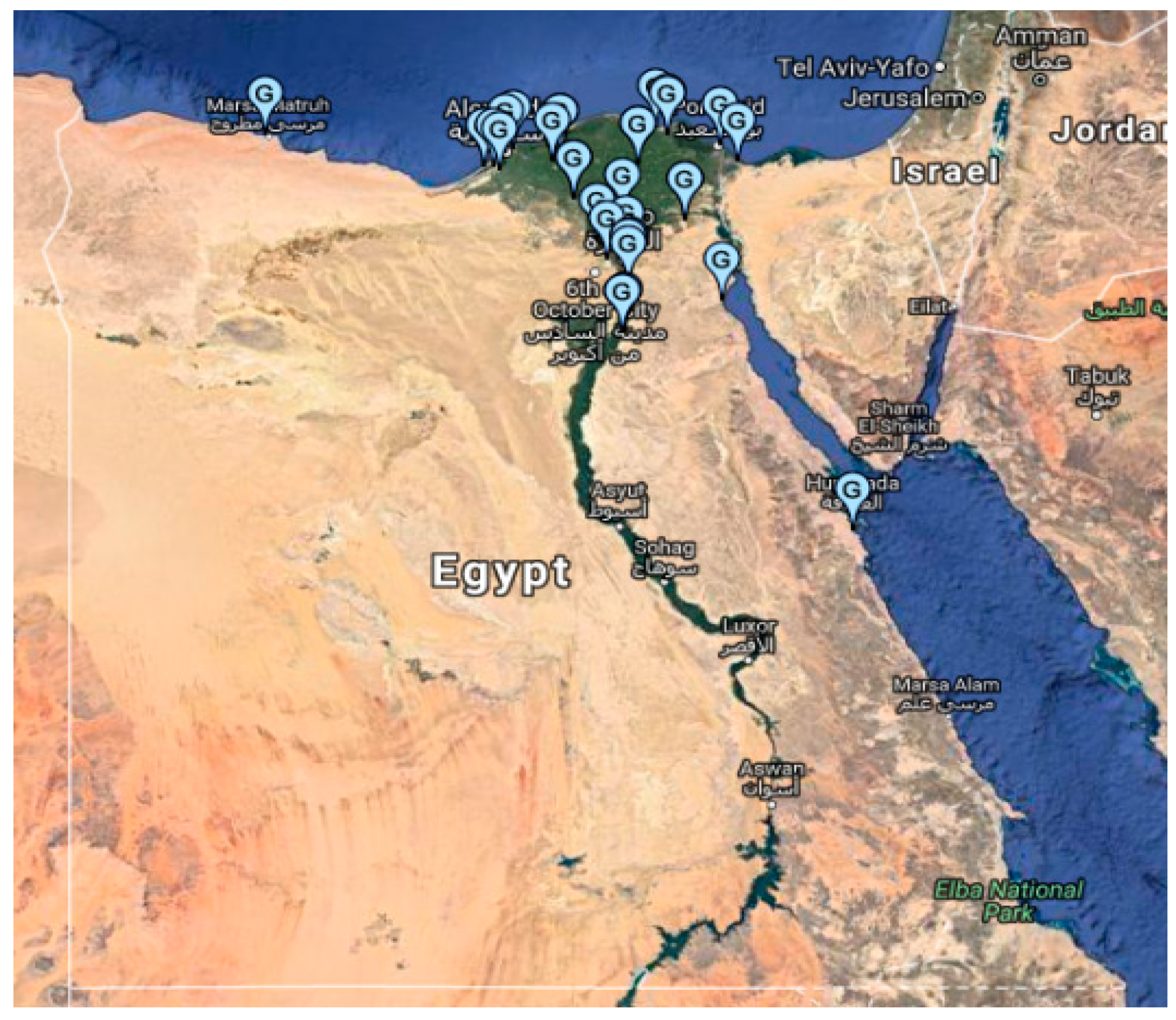

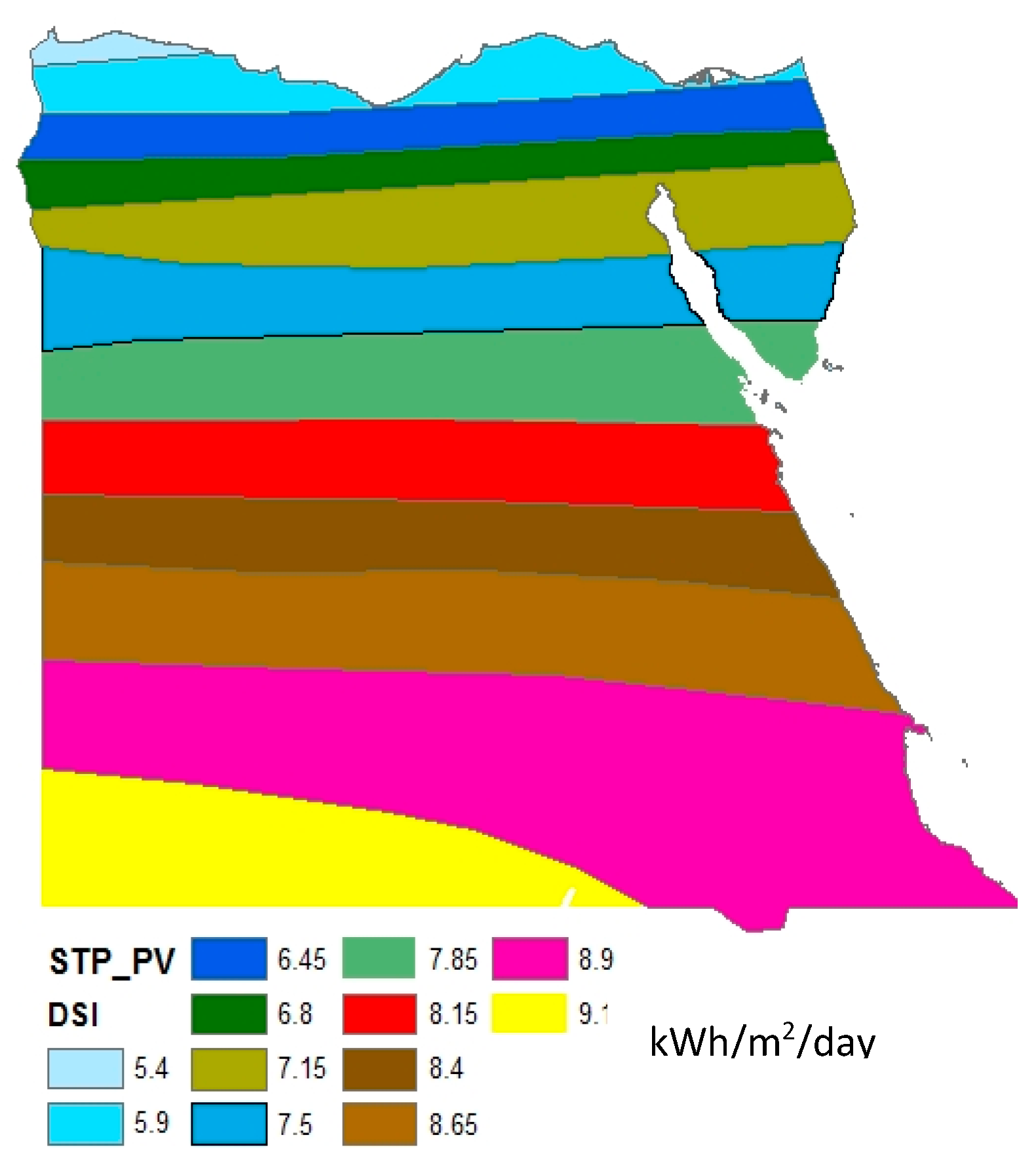
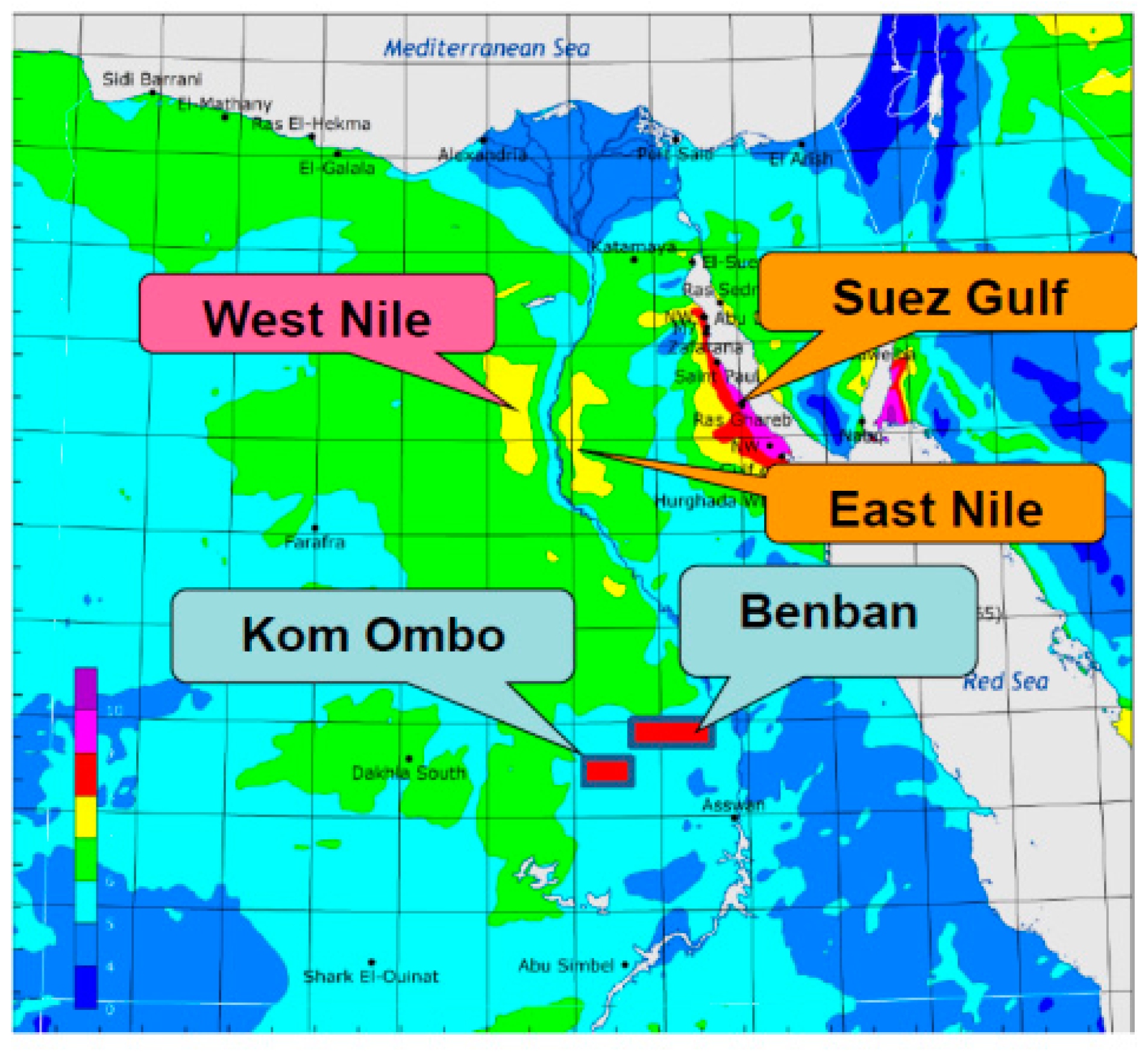

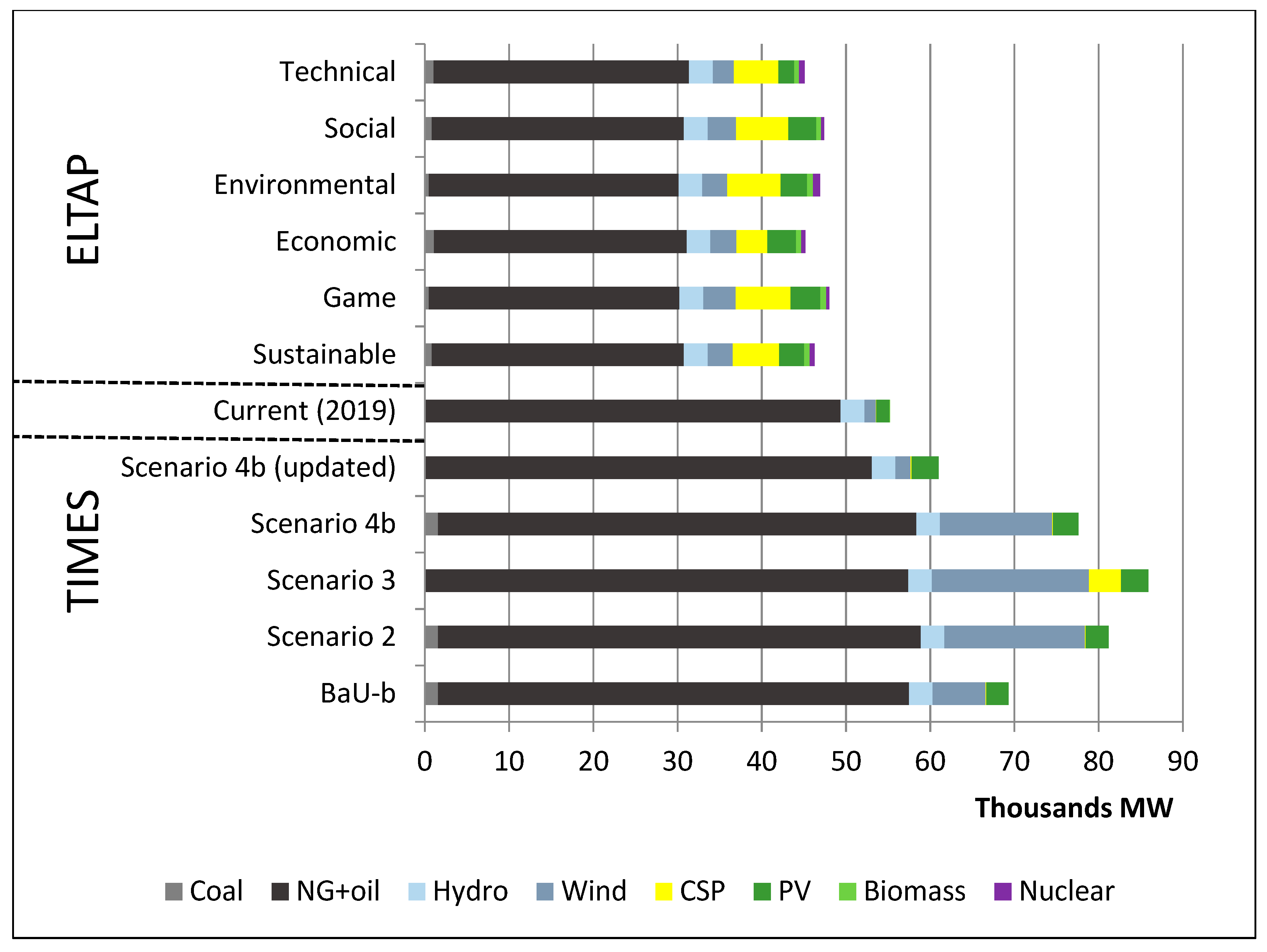
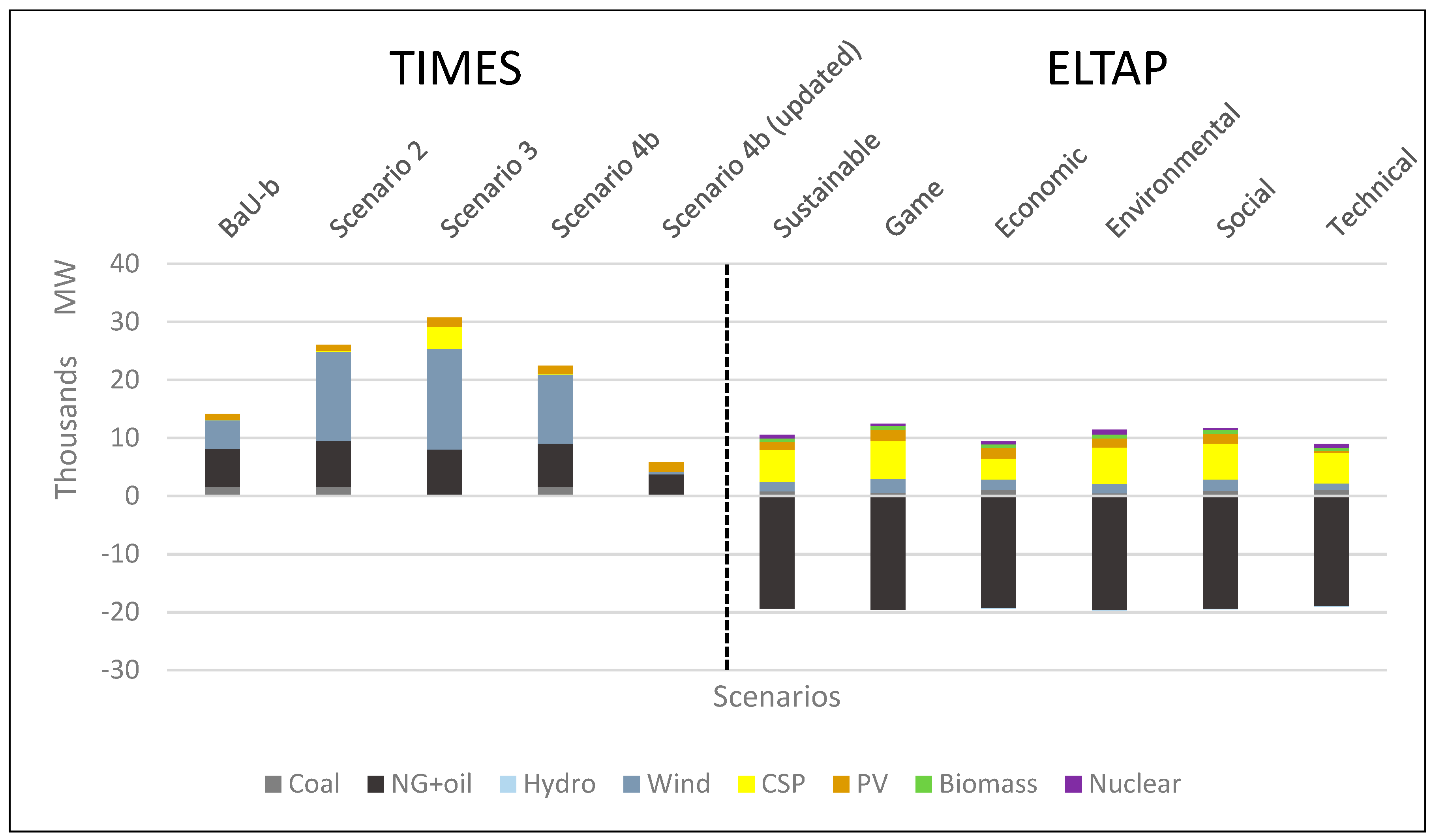

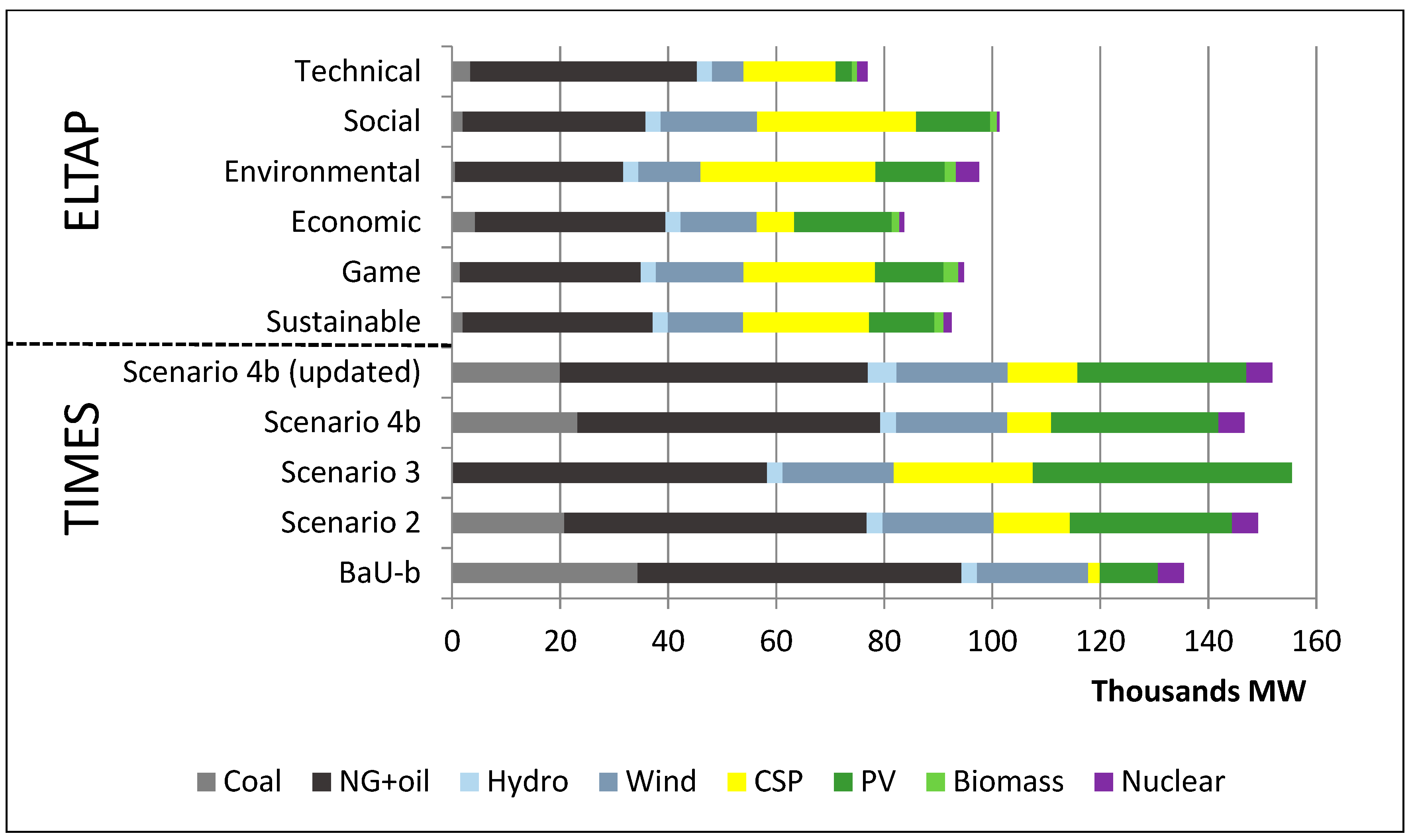
| Resource Potential | Coal * | NG * | Wind | CSP | PV | Biomass | Nuclear * |
|---|---|---|---|---|---|---|---|
| TWh/y | 0.41 | 90,588.24 | 7650 | 73,656 | 36 | 15.3 | 536.47 |
| Zone | Area (km2) | Capacity (MW) | |
|---|---|---|---|
| Suez Gulf (wind) | 1220 | 3550 | |
| East Nile | Wind | 841 | 5800 |
| Solar | 1290 | 34,900 | |
| West Nile | Wind | 3636 | 25,350 |
| Solar | 606 | 17,400 | |
| Benban (solar) | 37 | 1800 | |
| Kom Ombo (solar) | 7 | 260 | |
| Actual State | Planned Targets | |||||||||||||
|---|---|---|---|---|---|---|---|---|---|---|---|---|---|---|
| Year | GE (TWh/y) | IC (GW) | RE % *** | Hydro (MW) | Wind (MW) | PV (MW) | CSP (MW) | RE% | Hydro | Wind | PV | CSP | Coal | Nuc-lear |
| 2009 | 131 | 21.3 | 11.9% | 2800 11.2% | 430 0.7% | 10 * | - | 20% (2020) | (+)32 MW (2016) 8% (2020) | 7200 MW 12% (2020) | 20 MW (2017) | 20 MW (2010) 120 MW (2017) | - | - |
| 2010 | 139 | 22.7 | 10% | 2800 9.2% | 490 0.8% | - | - | - | - | - | - | - | - | - |
| 2011 | 147 | 23.5 | 9.9% | 2800 8.9% | 547 1.01% | - | 20 ** 34 GWh/y | - | (+)32 MW (2017) | - | - | - | - | - |
| 2012 | 157 | 25.7 | 9.2% | 2800 8.2% | 547 0.97% | - | 20 | 20% (2020) | 6% (2020) | 12% (2020) | 2% solar (2020) | - | - | |
| 700 MW (2027) | 2800 MW (2027) | |||||||||||||
| 2014 | 168 | 26.1 | 8.8% | 2800 8% | 547 0.8% | - | 20 | - | - | (+)250 MW | - | - | - | - |
| 2015 | 175 | 35.2 | 8.7% | 2800 7.9% | 547 0.8% | - | 20 | 20% (2022) | - | 1890 MW (2019) +970 MW | 2580 MW (2018) | (+)100 MW | - | 5 GW (2022) |
| 2016 | 186 | 38.9 | 8.4% | 2800 7.3% | 747 1.1% | 30 * | 20 | - | (+)32 MW (2017) | 7200 MW (2022) (+)500 MW (+)2000 MW (Fit) | (+)400 MW | (+)100 MW | - | - |
| (+)2300 MW (Fit) | ||||||||||||||
| 2017 | 189.5 | 45 | 7.96% | 2800 6.8% | 747 1.16% | 30 * | 20 | - | (+)2400 MW | (+)1070 MW | (+)400 MW | (+)100 MW | (+)2640 MW (+)6600 MW (2027) | |
| 2018 | 196.8 | 55.2 | 7.73% | 2832 6.5% | 967 1.2% | 44.2 * 50 0.03% | 20 | - | (+)2610 MW (2023) (+)2000 MW | (+)20 MW (+)26 MW | ||||
| 2019 | 199.8 | 58.4 | - | 2832 | 1127 | 1465 | 20 | 42% (2035) | (+)2650 MW | (+)1196 MW | (+)100 MW | |||
| 2020 | 197.4 | 59.5 | - | 2832 | 1385 | 1491 | 20 | 42% (2035) | (+) 500 (2023) | (+) 400 MW | ||||
| Modeling Methodology | Characteristics | Examples |
|---|---|---|
| Top-Down Energy Models | ||
| Computable general equilibrium (CGE) | It considers the whole economy and determines the equilibrium across all markets. It identifies important economic parameters endogenously. | GEM-E3; GTAP; SNOW |
| System dynamics | It explains the behavior of an interacting social system due to the assumed interdependencies, taking into consideration the dynamic changes over time of different components that represent the defined system. It is made up of flows, stocks, central components of the defined system, and feedback loops represented by non-linear differential equations. | POLES; ASTRA |
| Bottom-Up Energy Models | ||
| Partial equilibrium | It emphasizes balancing the economy of only one market, which would be the energy or electricity market. | MARKAL; ETM |
| Simulation | It allows testing of various topologies of systems and their impacts. Scenarios can be developed. | REEPS; WEM; MURE |
| Game theory | A type of simulation model focusing on the interaction of players in the energy market. | Cournot; Bertrand; Supply Function Equilibria |
| Accounting framework simulation | It accounts for the physical and economic flows of the energy system, specifically the outcomes of the assumed development in a descriptive or prescriptive manner. It is commonly applied to project future energy demand and related emissions of final energy sectors. | LEAP; BUENAS; MAED |
| Agent-based | A specific case of simulation model in which actors participating in the decision-making process are explicitly represented as agents having distinct behavior and objectives. | EMlab-Generation; PowerACE; ELTAP |
| Optimization | The aim of this model is to optimize a given quantity which is usually related to the system operation or investment or several aspects simultaneously. | MARKAL; TIMES; MESSAGE |
| Linear programming | This is an example approach of optimization methodology with an objective function to be maximized or minimized and subject to a set of constraints. | Temoa; PyPSA: OSeMOSYS |
| Mixed integer linear programming | This is another optimization approach which forces certain variables to be integral. | SWITCH; StELMOD |
| Mixed integer quadratically constrained programming | An optimization approach in which both the objective functions and the constraints are quadratic. | EUCAD |
| Covariance matrix adaptation evolution strategy | The optimal solution can be approximated. | GENESYS |
| Heuristic optimization | They do not necessarily find the optimum solution. | GENESYS; iHOGA |
| Hybrid Energy Models | ||
| Non-linear programming | An optimization approach with non-linear characteristics of the objective functions. | ReMIND |
| Mixed integer programming | See above | BALMOREL |
| Partial equilibrium | See above | POLES; PRIMES; GCAM |
| Simulation | See above | WEM |
| Scenarios | Oil and NG | Coal | Nuclear | Renewables * | Subsidies |
|---|---|---|---|---|---|
| Baseline scenario: Business as usual (BaU) | Employ the most likely forecast for indigenous production | Installed after 2020 | Apply the current national program for nuclear energy | Add not more than 1 GW of PV, 1 GW of wind, and 400 MW of CSP per year | Kept constant until 2035, reduced by 50% until 2020, and removed by 2025 |
| Scenarios 1: Different renewable development policy | Same as BaU | Available | Available | Three sub-scenarios: | Same as BaU (b) |
| 20% Target Scenario | Delayed Reference Scenario of the Combined Renewable Energy Masterplan (CREMP) | Minimum Fuel Scenario of the CREMP | |||
| Scenario 2: Delayed development and high-energy-efficiency policy | Same as Scenarios 1 | Same as Scenarios 1 | Delayed by five years | Three measures: | The same as Scenarios 1 |
| Same as Scenario 1 (b) | Introduction of higher rates of energy efficiency | Deployment of policy measures to promote more efficient equipment and behavioral changes | |||
| Scenario 3: High renewables policy | Not specified | Not included | Not included | High penetration policy | Not specified |
| Scenario 4: Least cost policy | All resources compete based on their relative cost. | Available | (a) free to compete (b) enforcing two operating units in 2025, the third in 2026, and the fourth in 2027. |
| Eliminated by 2020 |
| Criteria | TIMES-EG | ELTAP-EGY |
|---|---|---|
| Purpose | The model is used for the exploration of possible energy futures based on contrasted scenarios in Egypt. | The model simulates spatial behavioral adaptation of actors’ priorities of investments in future electricity technologies. These priorities are then allocated to the predicted electricity demand. |
| Modeling methodologies |
|
|
| Availability for use | 2008 | 2018 |
| Accessibility to the model | The source code for model generator is available free of charge upon providing a signed copy of the ETSAP Letter of Agreement to the ETSAP Operating Agent. | Free to download from the website of CoMSES Net (Network for Computational Modeling in the Social and Ecological Sciences) |
| Computer programming language | GAMS | Netlogo 5.3.1 |
| Temporal scale | 2010–2035 | 2015–2100 |
| Temporal resolution | 5 years | 1 year |
| Stakeholder involvement | They identified different future scenarios to be considered as constraints for the model. | They took part in identifying their preferences of the criteria that were utilized for the assessment of the technologies which reflect their decision behaviors in selecting a future technology. The social acceptance of the technologies has been considered through citizens’ participation in a survey. |
| Technology assessment parameters | Only technical and economic | It involves multiple sustainability dimensions (i.e., technical, economic, environmental, and social). |
| Spatial allocation of technologies | Not considered | The model ranks spatial units within the case study for the installation of a specific technology. |
| Case studies | Multi-regional | The model has been applied only to Egypt and its spatial units. |
| Demand prediction | Embedded in the model | Calculated separately |
| Scope | Covers all energy sectors | Addresses only the electricity sector |
| Scope of technologies | Biomass is not included. Combustion-type power plants have been specified for oil and natural gas (i.e., steam turbine, combined cycle, gas turbine, combined heat and power). | Biomass is included. Natural gas- and oil-fired plants have been considered without specifying turbine type. |
| Behavior of actors | Assumed to be optimal | Actors have an adaptive, unique behavior. |
| Difficulty of data collection and availability | Low, since it focuses on technical and economic inputs that are mostly available | High, since it involves the social and environmental dimensions as well as the preferences of different stakeholders |
| Complexity of the model and execution time | Low to medium | Medium to high |
| Exploitation of the results | Already in use by the government | For research purposes only |
Publisher’s Note: MDPI stays neutral with regard to jurisdictional claims in published maps and institutional affiliations. |
© 2022 by the authors. Licensee MDPI, Basel, Switzerland. This article is an open access article distributed under the terms and conditions of the Creative Commons Attribution (CC BY) license (https://creativecommons.org/licenses/by/4.0/).
Share and Cite
Shaaban, M.; Scheffran, J.; Elsobki, M.S.; Azadi, H. A Comprehensive Evaluation of Electricity Planning Models in Egypt: Optimization versus Agent-Based Approaches. Sustainability 2022, 14, 1563. https://doi.org/10.3390/su14031563
Shaaban M, Scheffran J, Elsobki MS, Azadi H. A Comprehensive Evaluation of Electricity Planning Models in Egypt: Optimization versus Agent-Based Approaches. Sustainability. 2022; 14(3):1563. https://doi.org/10.3390/su14031563
Chicago/Turabian StyleShaaban, Mostafa, Jürgen Scheffran, Mohamed Salah Elsobki, and Hossein Azadi. 2022. "A Comprehensive Evaluation of Electricity Planning Models in Egypt: Optimization versus Agent-Based Approaches" Sustainability 14, no. 3: 1563. https://doi.org/10.3390/su14031563
APA StyleShaaban, M., Scheffran, J., Elsobki, M. S., & Azadi, H. (2022). A Comprehensive Evaluation of Electricity Planning Models in Egypt: Optimization versus Agent-Based Approaches. Sustainability, 14(3), 1563. https://doi.org/10.3390/su14031563








